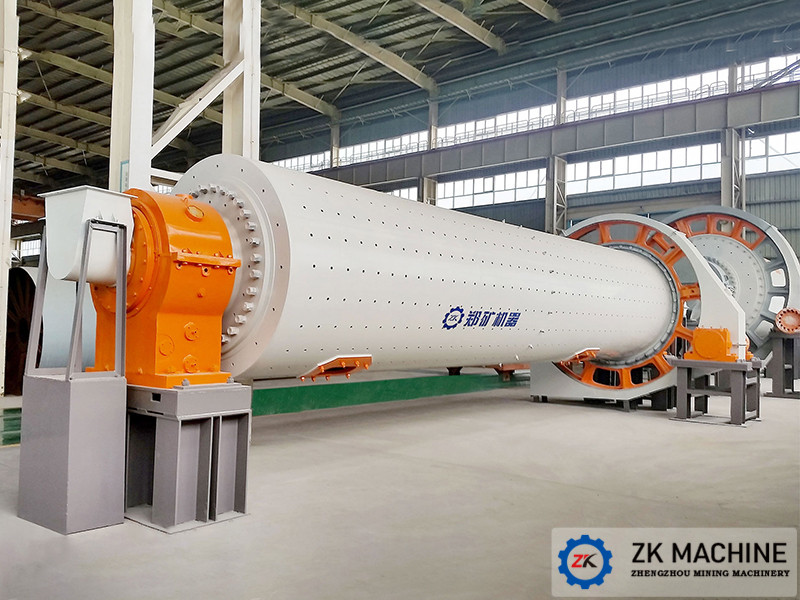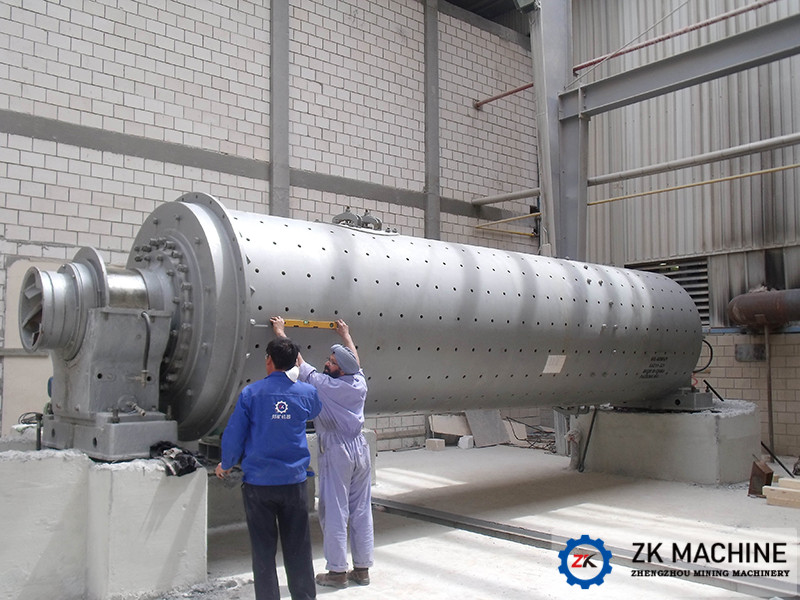Grinding Mills can be divided into ball mills, rod mills, tube mills, self-mills, roller mills, etc. according to the different grinding media and grinding materials.
Intermittent ball mills are commonly used in the production of ceramic industry. Wet production is used. The grinding effect can be divided into two parts, one is the grinding effect between the grinding body and the grinding body and the simplified, and the other is the impact when the grinding body falls In order to improve the grinding efficiency, we must start from these two aspects. The "more crushing and less grinding" technology and process of metal mines is a topic that has been mentioned for many years. Reducing the particle size of the ball mill and adding a section of pre-grinding or ultra-fine crushing process in front of the ball mill are important technological innovations for energy saving and consumption reduction in mining enterprises. The research of mill crushing process is one of the key points in mineral processing engineering technology. The crushing and grinding process is to use energy to squeeze, impact and grind the ore through the mill, so that the useful mineral monomers in the ore are cleaved, which facilitates the selection process in the next stage.

The most widely used in the classification of mills, and the most classic is the ball mill. Ball grinding mill (ball grinding mill) is the key equipment for crushing materials and then crushing. It is mainly used in cement, silicate products, new building materials, refractory materials, fertilizers, ferrous and non-ferrous metal beneficiation and glass ceramics production industries. The ball mill can be divided into two types: lattice type and overflow type according to different ore discharging methods. It can be divided into dry and wet grinding methods. It is suitable for grinding various ores and other materials, and is widely used in mineral processing, building materials and chemical industry. And other industries.

As the name implies, the ball mill uses steel balls as the grinding medium. Unlike the bar mill, the steel rods are in line contact, and the ball mills are in point contact, but their wear is uniform. The medium filling rate refers to the percentage of grinding media in the volume of the mill. For different grinding methods, mill structure, operating conditions and media shape, the media filling rate has a suitable range, too high or too low will affect the grinding effect. The filling rate of the ball mill is usually 40%-50%, and the rod mill is 35%-45%. The process characteristic of the rod mill is that the product is rough, but the particle size is uniform, the coarse particles and the slime are less, and the over crushing is lighter. And the particle size characteristics of the rod mill product are related to the condition of the rod milling ore. The performance characteristics of the ball mill are high production capacity, strong adaptability to the material, high degree of fineness of the material, fine particle size of the discharge, easy to fine grinding, energy saving is more obvious, but the phenomenon of over crushing is serious.
The above is the relevant introduction of the ball mill. I hope to help friends in need, understand the characteristics of the materials and the characteristics of the equipment, so as to choose the right product.
The above is the relevant introduction of the ball mill. I hope to help friends in need, understand the characteristics of the materials and the characteristics of the equipment, so as to choose the right product.Grinding Mills can be divided into ball mills, rod mills, tube mills, self-mills, roller mills, etc. according to the different grinding media and grinding materials.
Intermittent ball mills are commonly used in the production of ceramic industry. Wet production is used. The grinding effect can be divided into two parts, one is the grinding effect between the grinding body and the grinding body and the simplified, and the other is the impact when the grinding body falls In order to improve the grinding efficiency, we must start from these two aspects. The "more crushing and less grinding" technology and process of metal mines is a topic that has been mentioned for many years. Reducing the particle size of the ball mill and adding a section of pre-grinding or ultra-fine crushing process in front of the ball mill are important technological innovations for energy saving and consumption reduction in mining enterprises. The research of mill crushing process is one of the key points in mineral processing engineering technology. The crushing and grinding process is to use energy to squeeze, impact and grind the ore through the mill, so that the useful mineral monomers in the ore are cleaved, which facilitates the selection process in the next stage.
The most widely used in the classification of mills, and the most classic is the ball mill. Ball grinding mill (ball grinding mill) is the key equipment for crushing materials and then crushing. It is mainly used in cement, silicate products, new building materials, refractory materials, fertilizers, ferrous and non-ferrous metal beneficiation and glass ceramics production industries. The ball mill can be divided into two types: lattice type and overflow type according to different ore discharging methods. It can be divided into dry and wet grinding methods. It is suitable for grinding various ores and other materials, and is widely used in mineral processing, building materials and chemical industry. And other industries.
As the name implies, the ball mill uses steel balls as the grinding medium. Unlike the bar mill, the steel rods are in line contact, and the ball mills are in point contact, but their wear is uniform. The medium filling rate refers to the percentage of grinding media in the volume of the mill. For different grinding methods, mill structure, operating conditions and media shape, the media filling rate has a suitable range, too high or too low will affect the grinding effect. The filling rate of the ball mill is usually 40%-50%, and the rod mill is 35%-45%. The process characteristic of the rod mill is that the product is rough, but the particle size is uniform, the coarse particles and the slime are less, and the over crushing is lighter. And the particle size characteristics of the rod mill product are related to the condition of the rod milling ore. The performance characteristics of the ball mill are high production capacity, strong adaptability to the material, high degree of fineness of the material, fine particle size of the discharge, easy to fine grinding, energy saving is more obvious, but the phenomenon of over crushing is serious.
The above is the relevant introduction of the ball mill. I hope to help friends in need, understand the characteristics of the materials and the characteristics of the equipment, so as to choose the right product.Mills can be divided into ball mills, rod mills, tube mills, self-mills, roller mills, etc. according to the different grinding media and grinding materials.
Intermittent ball mills are commonly used in the production of ceramic industry. Wet production is used. The grinding effect can be divided into two parts, one is the grinding effect between the grinding body and the grinding body and the simplified, and the other is the impact when the grinding body falls In order to improve the grinding efficiency, we must start from these two aspects. The "more crushing and less grinding" technology and process of metal mines is a topic that has been mentioned for many years. Reducing the particle size of the ball mill and adding a section of pre-grinding or ultra-fine crushing process in front of the ball mill are important technological innovations for energy saving and consumption reduction in mining enterprises. The research of mill crushing process is one of the key points in mineral processing engineering technology. The crushing and grinding process is to use energy to squeeze, impact and grind the ore through the mill, so that the useful mineral monomers in the ore are cleaved, which facilitates the selection process in the next stage.
The most widely used in the classification of mills, and the most classic is the ball mill. Ball grinding mill (ball grinding mill) is the key equipment for crushing materials and then crushing. It is mainly used in cement, silicate products, new building materials, refractory materials, fertilizers, ferrous and non-ferrous metal beneficiation and glass ceramics production industries. The ball mill can be divided into two types: lattice type and overflow type according to different ore discharging methods. It can be divided into dry and wet grinding methods. It is suitable for grinding various ores and other materials, and is widely used in mineral processing, building materials and chemical industry. And other industries.
As the name implies, the ball mill uses steel balls as the grinding medium. Unlike the bar mill, the steel rods are in line contact, and the ball mills are in point contact, but their wear is uniform. The medium filling rate refers to the percentage of grinding media in the volume of the mill. For different grinding methods, mill structure, operating conditions and media shape, the media filling rate has a suitable range, too high or too low will affect the grinding effect. The filling rate of the ball mill is usually 40%-50%, and the rod mill is 35%-45%. The process characteristic of the rod mill is that the product is rough, but the particle size is uniform, the coarse particles and the slime are less, and the over crushing is lighter. And the particle size characteristics of the rod mill product are related to the condition of the rod milling ore. The performance characteristics of the ball mill are high production capacity, strong adaptability to the material, high degree of fineness of the material, fine particle size of the discharge, easy to fine grinding, energy saving is more obvious, but the phenomenon of over crushing is serious.
The above is the relevant introduction of the ball mill. I hope to help friends in need, understand the characteristics of the materials and the characteristics of the equipment, so as to choose the right product.





















